Today, Marcus reviews the Gustard H26, a fully balanced, discrete Class A headphone amplifier and preamplifier with up to 12W of output power. It's priced at $1,149.99.
Disclaimer: I was sent this as a sample in exchange for my honest opinion. Headfonics is an independent website with no affiliate links or services. I appreciate Shenzhen Audio and Gustard for your support.
To read more about Gustard Products We have previously reviewed it on Headfonics, click here.
Please note that this article follows our Latest Scoring Guidelines which you can read in more detail here.
The Gustard H26 is the company's latest flagship analog preamp and headphone amplifier, priced at $1,149.99. It joins its “26” range of desktop modular components, including the A26 Jarvin's previously reviewed DAC and a P26 preamp.
Gustard has positioned the H26 as a high-end all-in-one solution for both headphone and traditional HiFi users.
There's something for everyone here, whether it's balanced Class A discrete circuitry, up to 12W peak power for headphones, and dedicated inputs and outputs for power amps and DACs.
Performance-wise, it has a great resolution, holographic sound, with refined tuning that ranges from neutral to natural – nothing too sharp or dry. The H26 is also surprisingly IEM-friendly, but this beast is more intended for demanding headphones.
Competition is strong for solid-state desktop analog amplifiers, examples such as the Chord Electronics Years, HIFIMAN Preludeand the Ferrum OOR It will provide you with valid alternatives.
You can find out how I came to my conclusion about the H26's performance and how it compares to those 3 specific amps in more detail below.
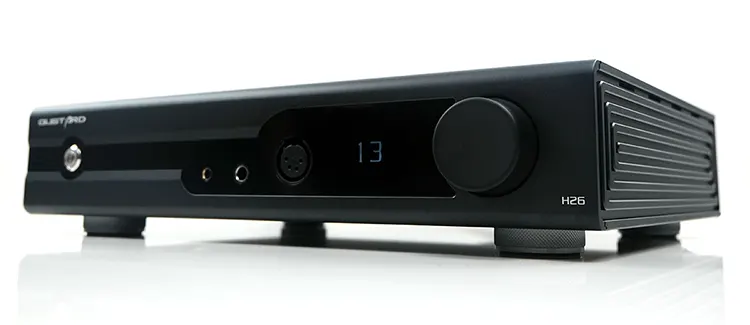

Characteristics
The Gustard H26 is a desktop-sized, fully balanced, discrete Class A preamplifier and headphone amplifier backed by two 50W toroidal transformers, one per channel.
Provides balanced and single-ended preamp, PO and LO output, dual RCA and 3-pin XLR analog input for DAC and other source equipment where applicable.
I should add that the fully discrete descriptor relates to no less than 8 pairs of power transistors with the preamp output using two directly inserted LME49720 op-amps that do not affect the headphone output.
All amplification circuit paths are independently powered, meaning you can keep the headphones and preamps on simultaneously or turn one off and keep the other on depending on your needs.
The H26, at least on paper, has excellent output specs. It has a balanced PO output power of up to 12W maximum into a 32Ω load, though there is a caveat with an additional clarification that it can only be used up to a maximum of 6W for distortion-free power.
I can only assume this is a disclaimer related to measurement, although most headphone users are unlikely to need more than 6W at that impedance level.
For Utopia 2022 and Susvara owners, the sweet spot is more likely to be the H26's 64Ω rating at a very healthy 7350mW down to just over 3W for Sennheiser HD 620S Headphones Fans and about 1.5W for ZMF headphones Atrium and HD 800 users.
With an additional user-controllable dual gain stage, the H26 should be able to drive or monitor almost any headphone currently available on the market.
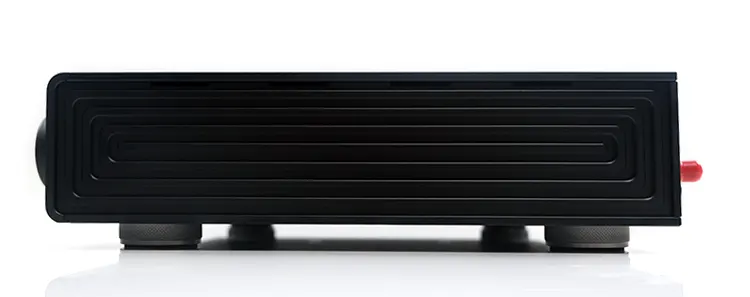

Design
The H26 is a powerful desktop amplifier that requires considerable space on the bench or in the rack. It measures 420mm wide x 360mm deep, 175mm high and weighs around 6kg (7kg with packaging).
You can buy it in two colour combinations, black or silver, both with a striking pattern-like finish on the side panels. The silver version is more of a two-tone, as it retains the black detailing on the side, front and rear panels.
The unit doesn't get too hot after several hours of use, so while it's not a low profile component, it is quite stackable.
For example, I currently stack the shallower but almost equally wide built-in panels. Surpassing DX9 If we add a DAC and an amplifier to the H26, I would still classify it as a stable and aesthetically pleasing combination.
The aesthetics of the H26 remind me of a mix of Schiit Audio's Yggdrasil smoothed-out tall chassis combined with a more modern digital LED display and matrix volume relay potentiometer dial on the far right.
It's minimalist, clean and uncluttered, yet imposing to the eye, and for old-school audiophiles, I dare say it might create a reassuring “bigger is better” feeling.
Importantly, there's consistent system potential here with the H26's design style matching the rest of the Gustard '26' series of desktop components, including the A26 and P26. In short, a stack of all three will look very harmonious if you have the space for them.
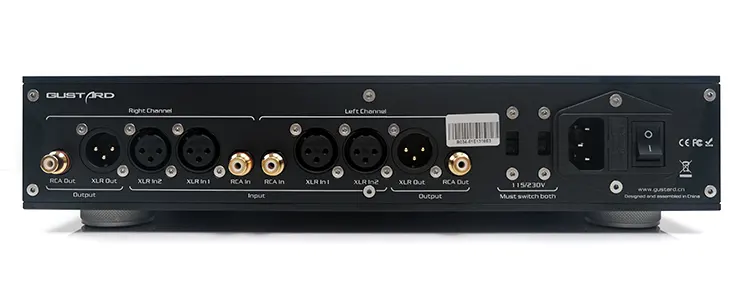

IS
The H26 has a wide range of analog inputs and outputs with clear labeling for each on the rear panel.
There is room for 6.35mm, 4.4mm and 4-pin XLR connectors on the front panel for headphones and IEM output, as well as 2 balanced 3-pin XLR inputs and a dual RAC set for single-ended analog line input on the rear panel.
It also includes a set of 4-pin balanced XLR and dual SE RCA connectors for preamp output functionality.
When I said width, I also meant physical width because both the H26's SE and balanced connectors are split per channel. That means if you have a tightly bonded or twisted IC (cable), you may need to split them due to how far apart the left and right connections can be.
Please note that the H26 has a regional voltage selector, so you need to make sure you have the correct setting before turning it on. In this case, ours is 220V, which was the default setting on my unit.
If you need to change the fuse next to the AC plug, the H26 uses a 3.15A rated version.
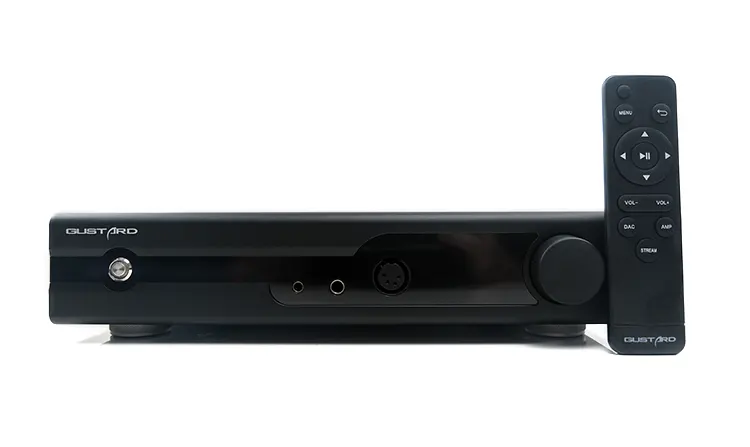

Control S
You have two ways to control the H26: via a lightweight plastic remote that runs on AAA batteries or manually via a multi-functional rotary volume dial on the front panel.
Manual control of the H26's menu mode is simple: simply press the volume dial once to access all input options. Once selected, turn the dial left or right to exit menu mode.
There is another layer to accessing the H26's high and low gain modes, accessed via a single long press of the same volume dial.
The remote is Gustard's usual “company universal”, a device I've used before when reviewing the X16 and X18 DACs, so I have a few of those lying around.
So you can think of it more as a control suite that goes beyond AMP functionality by being able to operate some of Gustard's DAC and streaming units as well.
You can switch between each component by pressing a DAC, amplifier or transmitter button on the bottom of the remote control.
All other options can be accessed via the remote control, including menu navigation/selection (directional and playback buttons) and volume control. You can switch between input options using the up navigation button without directly accessing the unit's menu.
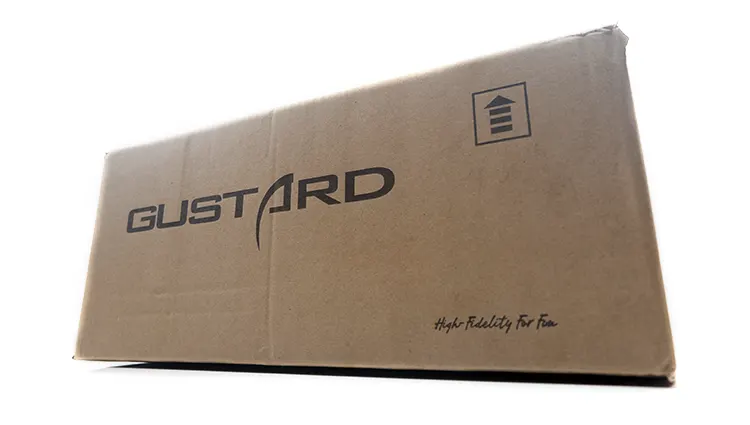

Packaging and accessories
The H26's packaging is a fairly typical large brown “HiFi” box, but I commend Gustard for the level of protective foam it includes inside to hold the unit securely because it is a fairly heavy device.
On top of that, the accessories are neatly packed inside two miniature boxes that include two AC cords with different plug configurations, the remote control, warranty cards, and the user manual.
Please note that both of my AC cords came with a 3-prong version and a 3-prong UK version with a fuse. I suspect that if you are ordering for the US, not only will your unit be set to 110V from the factory, but it should also come with a 2-prong type A and/or B cord.
Click to page 2 below for my sound impressions and recommended pairings.
Click on page 3 below to see my selected comparisons.
Sharing is caring!







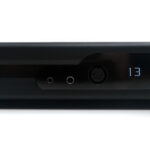






Leave feedback about this